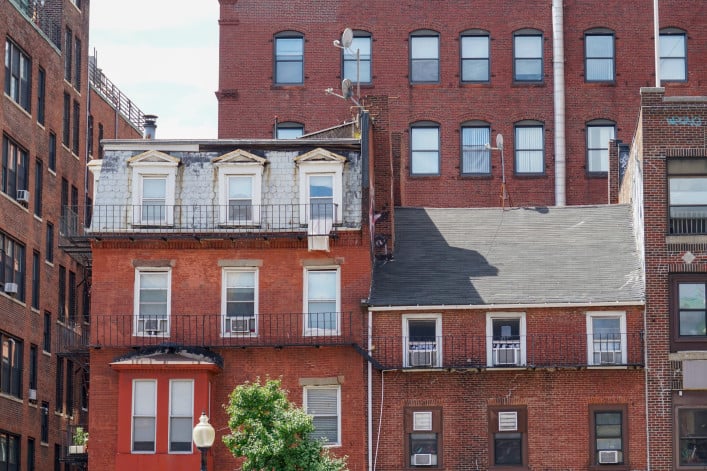What is the certificate of occupancy and why is it such a big deal?
- The C of O identifies how a building can be used and how many households are allowed at the address
- A lender will not approve a mortgage unless the C of O is accurate or there's a temporary C of O
- Tenants can withhold rent in a building lacking a correct C of O—and it's up to the owner to fix

A townhouse or apartment building cannot be legally occupied without a certificate of occupancy.
iStock
When you’re buying in New York City, one of the documents you will need to obtain is the certificate of occupancy, which is sometimes shortened to C of O or just CO. It identifies how a building can be used—for example, whether it is zoned for commercial or residential use—and how many households are allowed at the address.
What's more, if you’re a buyer seeking financing and the paperwork doesn’t match your planned use, the bank isn’t going to approve your mortgage.
And if you’re a tenant and find out the apartment doesn’t have a C of O, you can withhold rent from the landlord.
Read on for more about what you need to know about a certificate of occupancy.
[Editor's note: An earlier version of this article was published in November 2024. We are presenting it again with updated information for October 2025.]
What is the purpose of a C of O?
The certificate of occupancy, issued by the Department of Buildings, is needed for both townhouses and apartment buildings. There's also a document called a Temporary Certificate of Occupancy (or TCO), which indicates that a building is safe to inhabit but still has some outstanding work to be completed or permits to obtain before a C of O is granted.
At least one of these documents is required to occupy a building legally, so, except in rare instances, the city may issue a vacate order for buildings without them.
Not sure about your building's status? You can look up any property's C of O through the city's Buildings Information System.
If you’re a tenant, the burden is on your landlord to correct any missing documentation, and they can’t collect rent from you if there’s no C of O or TCO. (You should definitely check if a basement apartment has a C of O.)
Is a C of O needed to close?
If you're in the process of buying a condo or co-op and have found out it lacks a C of O or TCO, you’ll want this addressed immediately. Note that individual co-op units do not have certificates of occupancy. Instead there is one document for the entire building, which means your fate can be in management's hands.
“You don’t want to inherit other people’s legal messes,” said Dean Roberts, a real estate attorney at Norris McLaughlin. For starters, problems or delays with the C of O can disrupt your mortgage process. Banks require at least a TCO to issue financing.
Even lenders that consider a TCO for a mortgage may require additional stipulations for the loan approval, such as verification of the TCO and validation that it doesn't expire prior to the loan closing date. Appraisals and underwriting guidelines would also need to be met.
C of O problems tend to arise for buyers in new construction buildings, which may have a TCO but cannot obtain a finalized Certificate of Occupancy until they're completed. This scenario is relatively common.
"You’ll find that the C of O is always a moving target as far as when it’s going to arrive, so [the developer or sponsor] is doing their best to estimate, incentivize, and keep people in the transaction," said Nicholas Palance, founder of brokerage Highland Advisory.
To avoid the hassles and expenses associated with a delayed move-in date (such as the need for storage and the cost of a temporary place to stay), it may be worth adding an extra three months to the date a developer provides for building approval. Read: "A timeline for buying a new development condo: From preparing your financing to closing" for more on this journey.
How do you change a C of O?
Another common scenario in which buyers might encounter C of O issues is when a townhouse has been upgraded to create additional living space. For example, a two-family house that has been converted into a three family would typically need a new C of O, but some owners may neglect this step.
If you're undertaking significant renovations or purchasing a fixer-upper with the intention of doing extensive work, you may need to update the C of O in addition to obtaining all the requisite permits.
Any renovation that creates a change in the number of rooms or alters the use of the spaces will require a permit, so it's worth checking whether a change in occupancy has been triggered. A qualified architect will be able to review your plans and flag any potential issues.
The easiest solution is to hire an experienced expeditor to help speed up the paperwork. If you are the one doing the renovation and your contractor files through the DOB’s Professional Certification Program, you can receive the application approval and permit within one to two days.
If you’ve inherited an issue as a buyer, the time frame for getting the C of O to match the property will depend on the extent of the work, whether it is up to code, if the layout needs to be reconfigured to meet the DOB’s requirements, and whether the zoning for the property allows the change in the first place. Once the DOB receives an online request for a new C of O, it takes, on average, 10 business days to review the request and make a determination.
As a new owner, you would not be responsible for any violations related to illegal work performed by a previous owner provided you submit the required paperwork. However, you’d still need to ensure the property is brought up to code and any C of O issues are corrected.
How do C of O issues affect a sale?
Contracts for a new construction apartment often include a clause that allows you to get out of the purchase if the closing does not occur by a particular date. If the C of O or TCO is delayed beyond that date, you may be able to walk away from the deal.
Palance points out that it is essential to monitor TCO expiration dates closely.
“I had a $10 million deal derailed because an expired TCO renewal came one day after the buyer was able to back out of the contract. In a declining market, a drawn-out process presents an opportunity for the buyer to renegotiate a lower price with the leverage of walking away. In many cases, this can be avoided,” he said.
There are also situations where a building’s C of O may be missing or problematic, such as a condo conversion where the developer only obtained a TCO, or co-op buildings that are somehow in violation of the C of O.
Typically, any C of O problem in a condo or townhouse will be discovered in the title search.
"It's one of those things that needs to be addressed well before you close. As a buyer, first assess how serious the problem is and see if it's fixable," Roberts said. One solution is to have the seller set aside money in escrow, allowing you to fix the problem. Expeditors don't work for free.
—Earlier versions of this article contained reporting and writing by Emily Myers.
You Might Also Like




























